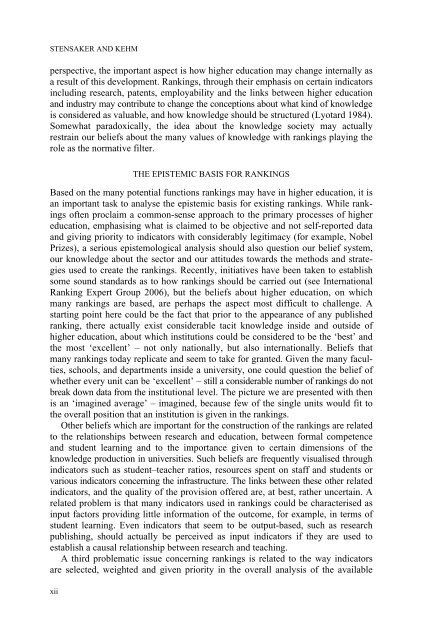University Rankings, Diversity, and the New ... - Sense Publishers
University Rankings, Diversity, and the New ... - Sense Publishers
University Rankings, Diversity, and the New ... - Sense Publishers
You also want an ePaper? Increase the reach of your titles
YUMPU automatically turns print PDFs into web optimized ePapers that Google loves.
STENSAKER AND KEHM<br />
perspective, <strong>the</strong> important aspect is how higher education may change internally as<br />
a result of this development. <strong>Rankings</strong>, through <strong>the</strong>ir emphasis on certain indicators<br />
including research, patents, employability <strong>and</strong> <strong>the</strong> links between higher education<br />
<strong>and</strong> industry may contribute to change <strong>the</strong> conceptions about what kind of knowledge<br />
is considered as valuable, <strong>and</strong> how knowledge should be structured (Lyotard 1984).<br />
Somewhat paradoxically, <strong>the</strong> idea about <strong>the</strong> knowledge society may actually<br />
restrain our beliefs about <strong>the</strong> many values of knowledge with rankings playing <strong>the</strong><br />
role as <strong>the</strong> normative filter.<br />
xii<br />
THE EPISTEMIC BASIS FOR RANKINGS<br />
Based on <strong>the</strong> many potential functions rankings may have in higher education, it is<br />
an important task to analyse <strong>the</strong> epistemic basis for existing rankings. While rankings<br />
often proclaim a common-sense approach to <strong>the</strong> primary processes of higher<br />
education, emphasising what is claimed to be objective <strong>and</strong> not self-reported data<br />
<strong>and</strong> giving priority to indicators with considerably legitimacy (for example, Nobel<br />
Prizes), a serious epistemological analysis should also question our belief system,<br />
our knowledge about <strong>the</strong> sector <strong>and</strong> our attitudes towards <strong>the</strong> methods <strong>and</strong> strategies<br />
used to create <strong>the</strong> rankings. Recently, initiatives have been taken to establish<br />
some sound st<strong>and</strong>ards as to how rankings should be carried out (see International<br />
Ranking Expert Group 2006), but <strong>the</strong> beliefs about higher education, on which<br />
many rankings are based, are perhaps <strong>the</strong> aspect most difficult to challenge. A<br />
starting point here could be <strong>the</strong> fact that prior to <strong>the</strong> appearance of any published<br />
ranking, <strong>the</strong>re actually exist considerable tacit knowledge inside <strong>and</strong> outside of<br />
higher education, about which institutions could be considered to be <strong>the</strong> ‘best’ <strong>and</strong><br />
<strong>the</strong> most ‘excellent’ – not only nationally, but also internationally. Beliefs that<br />
many rankings today replicate <strong>and</strong> seem to take for granted. Given <strong>the</strong> many faculties,<br />
schools, <strong>and</strong> departments inside a university, one could question <strong>the</strong> belief of<br />
whe<strong>the</strong>r every unit can be ‘excellent’ – still a considerable number of rankings do not<br />
break down data from <strong>the</strong> institutional level. The picture we are presented with <strong>the</strong>n<br />
is an ‘imagined average’ – imagined, because few of <strong>the</strong> single units would fit to<br />
<strong>the</strong> overall position that an institution is given in <strong>the</strong> rankings.<br />
O<strong>the</strong>r beliefs which are important for <strong>the</strong> construction of <strong>the</strong> rankings are related<br />
to <strong>the</strong> relationships between research <strong>and</strong> education, between formal competence<br />
<strong>and</strong> student learning <strong>and</strong> to <strong>the</strong> importance given to certain dimensions of <strong>the</strong><br />
knowledge production in universities. Such beliefs are frequently visualised through<br />
indicators such as student–teacher ratios, resources spent on staff <strong>and</strong> students or<br />
various indicators concerning <strong>the</strong> infrastructure. The links between <strong>the</strong>se o<strong>the</strong>r related<br />
indicators, <strong>and</strong> <strong>the</strong> quality of <strong>the</strong> provision offered are, at best, ra<strong>the</strong>r uncertain. A<br />
related problem is that many indicators used in rankings could be characterised as<br />
input factors providing little information of <strong>the</strong> outcome, for example, in terms of<br />
student learning. Even indicators that seem to be output-based, such as research<br />
publishing, should actually be perceived as input indicators if <strong>the</strong>y are used to<br />
establish a causal relationship between research <strong>and</strong> teaching.<br />
A third problematic issue concerning rankings is related to <strong>the</strong> way indicators<br />
are selected, weighted <strong>and</strong> given priority in <strong>the</strong> overall analysis of <strong>the</strong> available














